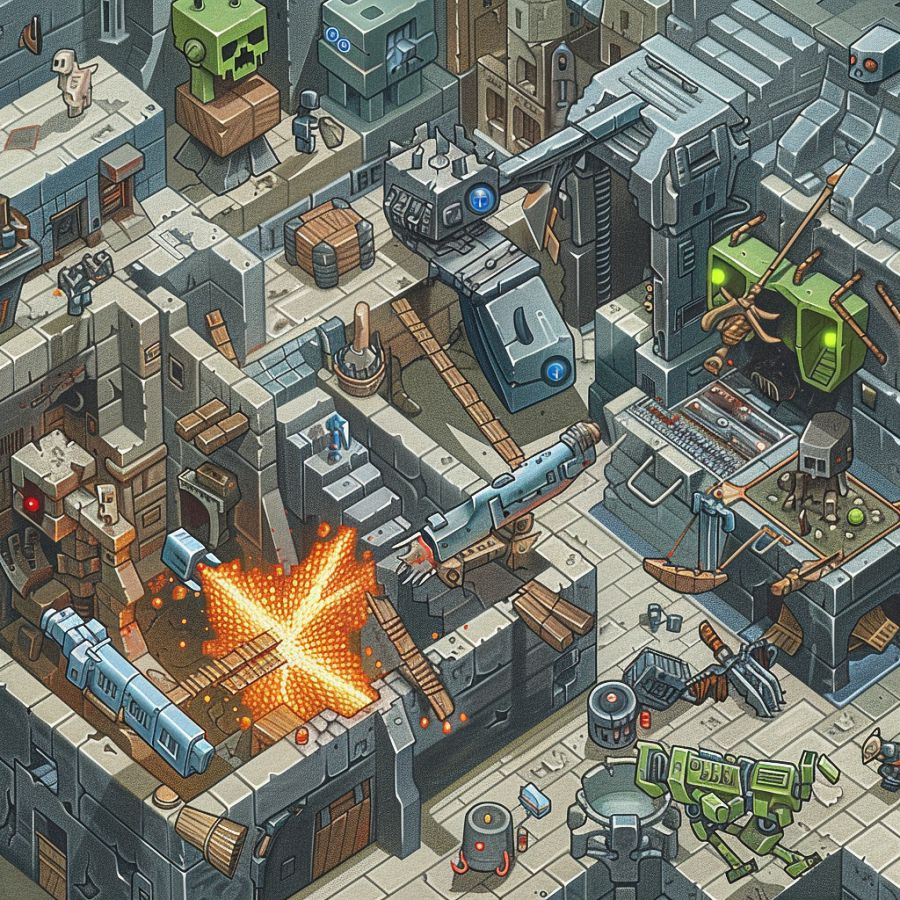How to Disable Mob Spawning in Minecraft


Understanding Mob Spawning in Minecraft
What is Mob Spawning?
In the world of Minecraft, understanding how to disable mob spawning is crucial for players looking to control their environment. Mob spawning refers to the process by which creatures, or “mobs,” appear in the game world. These mobs can be anything from friendly animals like cows and chickens to dangerous creatures like zombies and skeletons.
Contents
ToggleMob spawning is a core mechanic that adds excitement and challenge to the game. For instance, hostile mobs come out at night or in dark areas, creating a sense of urgency for players to build shelters and gather resources. However, there are times when players might want to disable mob spawning, such as when creating intricate builds without interference or ensuring safety in a survival world.
Types of Mobs: Hostile, Passive, and Neutral
Minecraft categorizes its mobs into three main types: hostile, passive, and neutral. Each type has distinct behaviors and spawning conditions that affect gameplay differently.
Hostile Mobs are the ones players most often seek to disable. These include creatures like creepers, zombies, skeletons, and spiders. They spawn in low light conditions, typically at night or in unlit caves. Hostile mobs attack players on sight, making it essential to manage their spawning for a safer environment.
Passive Mobs are non-threatening and include animals like sheep, pigs, cows, and chickens. They spawn in well-lit areas during the day and are primarily useful for resources like food, wool, and leather. Disabling their spawning is less common but can be useful in certain custom maps or farms where specific control is needed.
Neutral Mobs occupy a middle ground, behaving passively until provoked. Examples include wolves, endermen, and zombified piglins. Their spawning can add a layer of complexity to gameplay, as they won’t attack unless the player engages them first. Managing neutral mob spawning can help maintain peace in specific game areas.
Default Spawning Conditions for Mobs
Understanding the default spawning conditions for mobs is key to effectively disabling them. Each mob type has unique conditions under which it spawns, influenced by factors such as light level, biome, and time of day.
Light Levels play a crucial role in mob spawning. Hostile mobs, for instance, require a light level of 7 or lower to spawn. This is why players often place torches around their bases to prevent these creatures from appearing. Passive mobs, conversely, need higher light levels and typically spawn during the day in open fields.
Biomes also dictate mob spawning. Different biomes support the spawning of different mobs. For example, ocelots are found in jungles, while polar bears spawn in icy biomes. Knowing the biome-specific spawning rules helps in targeting mob control efforts effectively.
Time of Day influences when mobs appear. Hostile mobs predominantly spawn during nighttime or in dark areas like caves. Passive mobs spawn in daylight, making the time of day a crucial factor in managing mob populations.
To disable mob spawning, players can use various in-game commands, modify game settings, or employ specific techniques like lighting up areas or using mods. By understanding the intricacies of mob spawning, players can tailor their Minecraft experience to suit their needs, whether they seek a peaceful building environment or a controlled challenge in their survival adventures.

Methods to Disable Mob Spawning
Using Game Commands: How to Use “/gamerule doMobSpawning false”
One of the simplest ways to disable mob spawning in Minecraft is by using the game command “/gamerule doMobSpawning false”. This command, when executed, stops all mobs from spawning in the game world, providing players with a peaceful environment to build and explore without interruptions.
To use this command, follow these steps:
- Open the chat window in your game. You can do this by pressing “T” on your keyboard.
- Type “/gamerule doMobSpawning false” and press “Enter”.
Voilà! You’ve now disabled mob spawning. This command is particularly useful in creative mode or on multiplayer servers where players want to focus on building without the hassle of dealing with hostile mobs. Remember, this command only prevents new mobs from spawning, it doesn’t remove existing ones. To clear out existing mobs, you might want to use the “/kill @e[type=!player]” command.
Adjusting Difficulty Settings to Prevent Hostile Mobs
Another method to control mob spawning is by adjusting the game’s difficulty settings. Minecraft offers four difficulty levels: Peaceful, Easy, Normal, and Hard. Each level impacts mob behavior and spawning rates.
To reduce or prevent hostile mobs from spawning, consider setting the game to Peaceful mode. Here’s how:
- Pause the game and open the “Options” menu.
- Select “Difficulty” and choose “Peaceful”.
In Peaceful mode, all hostile mobs disappear, and new ones won’t spawn. This mode is ideal for younger players or those looking to enjoy Minecraft without the threat of creepers or zombies. If you’re playing on a server, you can change the difficulty by using the command “/difficulty peaceful”.
Implementing Peaceful Mode for Automatic Mob Disabling
Peaceful mode isn’t just about turning off hostile mobs, it also automatically disables hunger and health regeneration becomes much faster. This mode is perfect for players who want a stress-free Minecraft experience.
In Peaceful mode:
- Hostile mobs don’t spawn at all.
- Your health regenerates quickly without needing food.
- There’s no need to worry about survival mechanics like hunger.
To enable Peaceful mode, simply go to the “Options” menu and set the difficulty to “Peaceful”. This mode is a great way to let kids or new players get acquainted with Minecraft’s building and exploration aspects without any danger.
Utilizing Mob Spawners and How to Deactivate Them
Mob spawners are blocks found in dungeons, mineshafts, and strongholds that generate specific mobs. These spawners can be a source of endless enemies if not dealt with properly. To deactivate a mob spawner, you need to understand its mechanics and apply the right strategy.
Here are some steps to deactivate a mob spawner:
- Light it Up: Place torches on all sides of the spawner. Mobs need darkness to spawn, so lighting up the area will prevent them from appearing.
- Use Blocks: Completely encase the spawner in blocks. This method ensures no space for mobs to spawn.
- Destroy the Spawner: If you’re not interested in keeping the spawner for a potential mob farm, break it with a pickaxe. Note that this is a permanent solution, and you’ll lose the spawner.
Deactivating mob spawners is crucial for maintaining control over your environment, especially in survival mode where resources can be limited.
Using Light Sources to Prevent Spawning in Specific Areas
One of the most effective ways to prevent mob spawning is by using light sources. Mobs like zombies, skeletons, and creepers require a light level of 7 or lower to spawn. By strategically placing light sources, you can ensure your areas remain mob-free.
Here are some lighting tips:
- Torches: Place torches every few blocks to maintain a light level above 7.
- Glowstone and Sea Lanterns: These blocks provide higher light levels and are great for large builds.
- Jack o’Lanterns: These provide a festive lighting option that doubles as a light source.
Consider using the F3 key to check light levels. This will help you place light sources more effectively. By keeping your areas well-lit, you can enjoy a safer and more controlled Minecraft environment.
By utilizing these methods, you can master how to disable mob spawning in Minecraft, creating the perfect balance for your gaming experience. Whether you prefer peaceful building or want to keep your survival world safe from hostile threats, these techniques offer comprehensive solutions to manage mob spawning effectively.

Advanced Techniques and Mods for Disabling Mob Spawning
Installing and Using Minecraft Mods: Top Mods for Mob Control
Minecraft mods offer powerful tools for players seeking advanced control over mob spawning. These mods introduce new functionalities and adjustments beyond the game’s default settings.
-
MCEdit Unified: This mod allows players to edit their Minecraft worlds extensively. You can use it to remove existing mobs or prevent them from spawning in designated areas by altering the game’s map files.
-
Light Level Overlay Reloaded: This mod provides a visual representation of light levels across your Minecraft world. It helps you pinpoint areas where mobs might spawn due to insufficient lighting, allowing for targeted adjustments.
-
JourneyMap: While primarily a mapping tool, JourneyMap also offers features to track mob spawn locations. You can use this information to strategically place torches or other light sources to prevent future spawning.
Configuring Server Settings to Manage Mob Spawning
For players on multiplayer servers, configuring server settings is crucial to manage mob spawning effectively. Server administrators can adjust settings to create a tailored gameplay experience.
-
Spigot/Bukkit Plugins: Platforms like Spigot and Bukkit offer plugins such as “WorldGuard” and “Essentials” that enable server admins to control mob spawning rates, disable specific mob types, or adjust spawning conditions based on player preferences.
-
Server.properties File: Directly editing the server.properties file allows admins to modify global settings like difficulty levels and mob spawning rules. This method provides precise control over the server environment without relying on in-game commands.
Creating Custom Command Blocks for Precise Mob Control
Command blocks in Minecraft are powerful tools that execute commands when activated. They can be programmed to disable mob spawning in specific areas or under certain conditions.
- Setting Up Command Blocks: Place command blocks strategically in your world and input commands like “/gamerule doMobSpawning false” to prevent mob spawning in designated zones. This method is ideal for creating custom adventure maps or challenge courses.
Setting Up Redstone Devices to Automatically Control Mob Spawns
Redstone, Minecraft’s equivalent of electrical circuits, can be used to create automated systems for controlling mob spawns. These devices trigger actions based on player proximity or other conditions.
-
Redstone Lamps: Connect redstone circuits to lamps or other light sources to automatically light up areas prone to mob spawning. This setup prevents mobs from appearing in those zones without player intervention.
-
Timer Circuits: Use redstone repeaters and comparators to create timers that activate lights or other deterrents periodically. This method ensures continuous control over mob spawning throughout gameplay sessions.
Exploring Third-Party Plugins for Server-Side Mob Management
Beyond Minecraft’s vanilla options, third-party plugins offer extensive features for server-side mob management. These plugins cater to various gameplay styles and server configurations.
-
EssentialPlugins: Provides essential tools for server management, including mob spawning control, player permissions, and economy systems. Admins can customize gameplay mechanics to suit their server community’s preferences.
-
WorldEdit: While primarily a world-editing tool, WorldEdit includes features for manipulating mob spawners and adjusting spawning rules. Server admins can use it to create unique spawning conditions or disable specific mobs entirely.
By leveraging these advanced techniques and mods, Minecraft players can gain precise control over mob spawning mechanics. Whether you’re fine-tuning your single-player world or managing a bustling multiplayer server, these tools empower you to create customized gameplay experiences tailored to your preferences and challenges.


